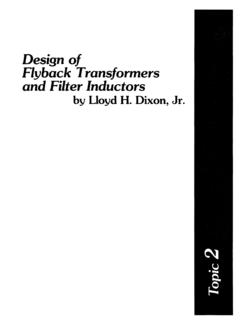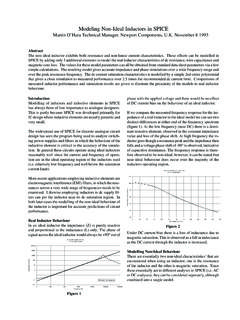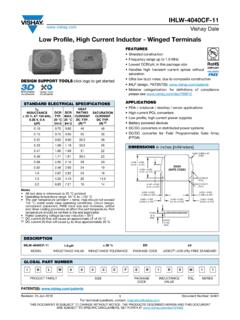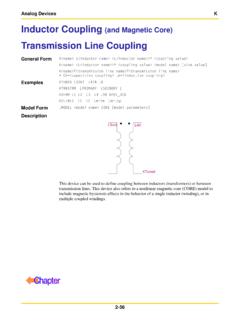Transcription of MEASUREMENTS OF INDUCTOR PROPERTIES VS …
1 1 MEASUREMENTS OF INDUCTOR PROPERTIES VS. NUMBER OF TURNS AND AIR GAP Lindsay Wilson 20/07/12 INTRODUCTION CORE USED AND measurement METHOD The dimensions of the ferrite core are shown in Fig. 1 and a photo in Fig. 2. The core is from a standard TV flyback and was originally gapped by about FIG. 1: CORE DIMENSIONS (MM) FIG. 2: CORE AND COIL PHOTO A coil was wound on a diameter former using diameter wire. The coil was placed centrally over the join between the core halves. Inductance and saturation current were measured by applying a constant voltage pulse to the coil and observing the increasing current waveform with a sense resistor. Fig. 3 and Fig. 4 show the circuit used to test the INDUCTOR . FIG. 3: TESTING CIRCUIT FIG. 4: PHOTO OF TESTING CIRCUIT For an excellent reference on INDUCTOR and core construction, including the effect of gapping, please see: sec!
2 OnCross sec!onD1 BYV32-200 Pulse inputCurrent senseR150m Q1 IRF640L1 Testinductor+30V0V2 INDUCTANCE AND INDUCTANCE FACTOR (AL) VS. TURNS The inductance was measured with different numbers of turns on the core. This was done for both an ungapped core and a gap of The inductance is shown in Fig. 5. The inductance factor, AL, measured in nH, is calculated from the inductance & number of turns and is shown in Fig. 6. The inductance factor is used in the equation L= AL*N2 to calculate the inductance from the number of turns. FIG. 5: INDUCTANCE VS. TURNS FIG. 6: INDUCTANCE FACTOR VS. TURNS Unsurprisingly, the inductance shows a parabolic relationship to the number of turns, since the calculated value of the inductance factor is reasonably independent of the turns. The inductance is lower with a gapped core - AL is around 2500nH turns-2 for an ungapped core, and around 1000nH turns-2 for a gap.
3 SATURATION CURRENT AND AMPERE-TURNS VS. TURNS Fig. 7 shows the saturation current vs. turns. As the number of turns is decreased, the saturation current increases, since it takes a higher current to produce the same field strength inside the core. Additionally, a gapped core results in a much higher saturation current nearly 3x, with only a gap. If we plot the ampere-turns required for saturation (obtained by simply multiplying saturation current by the number of turns), Fig. 8, we see that it is relatively independent of the turns around 20 for an ungapped core, and around 60 for a gap. FIG. 7: SATURATION CURRENT VS. TURNS FIG. 8: SATURATION AMPERE-TURNS VS. TURNS This is interesting for a particular core configuration, it is the ampere-turns which determines when the core saturates.
4 For example, if we had 100 turns on an ungapped core, the saturation current would be 20/100= 02468101214161802004006008001000 No gap gapInductance (uH)# Turns02468101214161805001000150020002500 3000 No gap gapInductance factor AL# Turns024681012141618024681012 No gap gapSaturation current (A)# Turns02468101214161801020304050607080 No gap gapAmpere turns for saturation# Turns3 MAXIMUM STORED ENERGY VS. TURNS Fig. 9 shows how the maximum stored energy varies with turns. This is calculated from E=1/2*L*ISAT2. Ignoring the slight variation, which is due to uncertainty in determining the exact saturation current, the maximum stored energy remains constant, regardless of turns. In addition, the energy is higher with a gapped core significantly higher, increasing from to 2mJ with only a gap.
5 This is because, although the inductance decreases with an air gap (in this example, by about , see Fig. 6), the saturation current increases by about 3x, and since the energy is proportional to the square of the current, this outweighs the effect of a smaller inductance. This is the second interesting point the energy storage limit does not depend on the number of turns, but only on the core and gap configuration. Which makes some sense, because, after all, the energy is being stored in the core and air gap. FIG. 9: MAXIMUM STORED ENERGY VS. TURNS INDUCTANCE AND INDUCTANCE FACTOR (AL) VS GAP Having seen the effect of the number of turns on various parameters, we now look at the effect of the air gap. In all the following graphs, the number of turns was constant at Fig. 10 and Fig. 11 show the inductance and inductance factor vs.
6 Air gap. As expected, both decrease sharply as the gap is increased (sort of exponentially), but the decrease slows above about FIG. 10: INDUCTANCE VS. GAP FIG. 11: INDUCTANCE FACTOR VS. GAP No gap gapMaximum energy (mJ)# (uH)Gap (mm) factor ALGap (mm)4 SATURATION CURRENT AND AMPERE-TURNS VS. GAP Next, Fig. 12 and Fig. 13 show the saturation current and saturation ampere-turns vs. gap spacing. Both increase approximately linearly. The increase is huge for example, a gap results in a saturation current of around 10A over twenty times the saturation current with an ungapped core. FIG. 12: SATURATION CURRENT VS. GAP FIG. 13: SATURATION AMPERE-TURNS VS. GAP MAXIMUM STORED ENERGY VS. GAP Fig. 14 shows the maximum stored energy vs. the gap spacing. Again, since the effect of an increased saturation current is more significant than the reduced inductance, the energy limit increases with gap spacing.
7 The effect is, again, dramatic a gap results in around sixteen times more stored energy than an ungapped core. FIG. 14: MAXIMUM STORED ENERGY VS. GAP CONCLUSIONS Both the saturation current and maximum stored energy are independent of the number of turns and depend only on the core and gap configuration. As the core gap is increased, the saturation current increases approximately linearly, while the inductance factor decreases sort of exponentially. I realize these results are probably obvious to people who know about inductors and magnetics, but I find it nice to have some experimental demonstration of them! current (A)Gap (mm) turns for saturationGap (mm) energy (mJ)Gap (mm)







